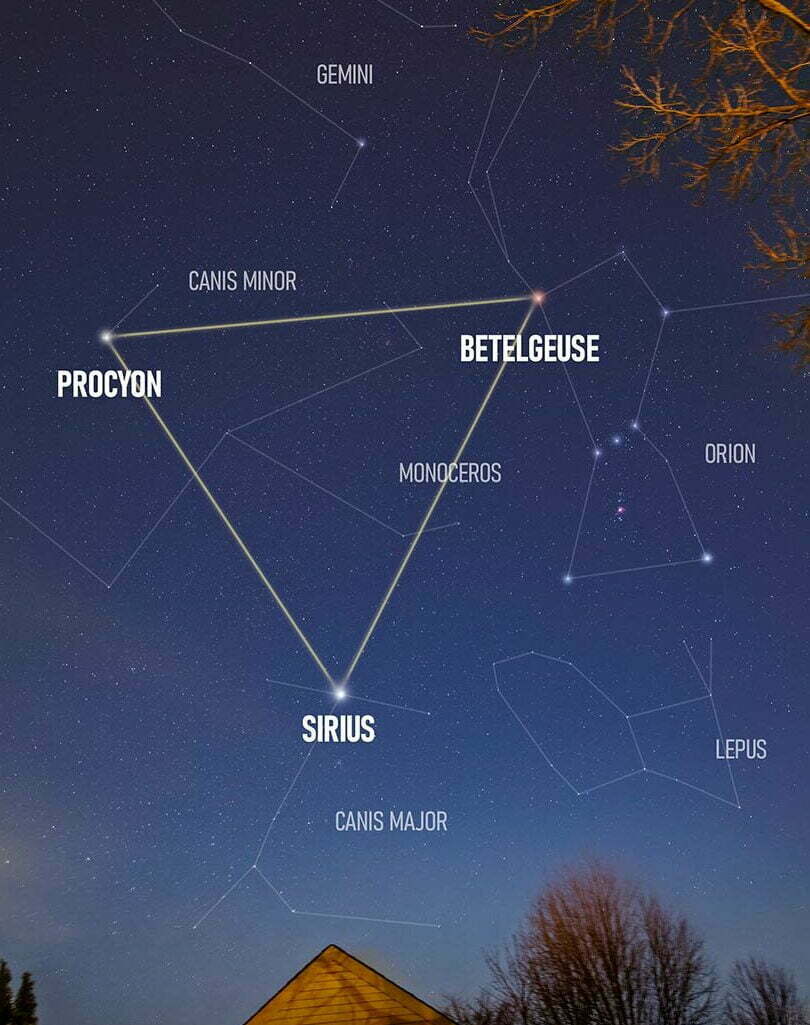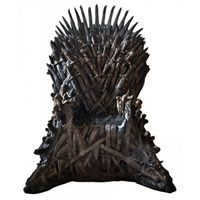
BETHELGEISE represents the CONFLICT FOR GLOBAL DOMINANCE or the BATTLE FOR WORLD LEADERSHIP, accompanied by the STRUGGLE for this position, and the SUFFERING that arises from this ongoing conflict.
Because, as Viktor Tsoi, in whose horoscope this star was prominent, once sang: ten thousand years of warfare. Warfare without a specific cause. War is the domain of the youth, a remedy for premature aging.
It is not without reason that Indian astrology refers to this star as ARDRA (The Needle), symbolizing the PAIN that war inflicts upon humanity.
And if there is any purpose to be found in this war, it is simply this – war serves as a testing ground for individuals, where everyone must demonstrate their finest qualities and conquer their weaknesses and vices through fierce struggle.
Thus, the primary contenders in this battle frequently turn out to be close kin – siblings, who fiercely compete for the privilege to establish their own life principles in the World they have inherited from their parents.
Despite the notion that close relatives should be the most dependable allies, it is more common in reality for relatives to act as relentless rivals rather than cooperative partners.
This is how the intricate dialectics of destiny is manifested within the confines of this archetype.
ARCHETYPE AND MYTHICAL IMAGE
Redefining the Essence of Archetypes and Mythical Images
The concept of archetypes and mythical images has long fascinated scholars and researchers in various fields, including psychology, anthropology, and literature. These universal symbols and patterns have been studied extensively, but their essence still remains elusive. This paper aims to redefine the nature of archetypes and mythical images by exploring their origins, functions, and significance in human society.
Exploring the Origins of Archetypes and Mythical Images
Archetypes and mythical images are deeply rooted in the collective unconscious, as proposed by Carl Jung. They are inherited patterns of thought and behavior that are present in all humans, transcending cultural and historical boundaries. These archetypes and images emerge from the depths of the human psyche, reflecting fundamental human experiences and desires.
The Functions of Archetypes and Mythical Images
Archetypes and mythical images serve several functions in human society. Firstly, they provide a framework for understanding and interpreting the world. These universal symbols help individuals make sense of their experiences and navigate the complexities of life. They also play a crucial role in shaping cultural values and beliefs, providing a shared language and mythology that binds communities together.
The Significance of Archetypes and Mythical Images
Archetypes and mythical images have profound significance in the human experience. They tap into the deepest levels of human consciousness, evoking primal emotions and instincts. These symbols and patterns have the power to stir our imagination, inspire creativity, and connect us to something greater than ourselves. They provide a sense of meaning and purpose, guiding us on our journey of self-discovery and personal growth.
In conclusion, archetypes and mythical images are complex and multifaceted concepts that defy easy definition. However, by exploring their origins, functions, and significance, we can gain a deeper understanding of their role in human society. These universal symbols and patterns hold a timeless appeal, transcending time and culture, and continue to shape our collective consciousness.

In Sumerian astrology, Betelgeuse represented the tip of the arrow of NINURTA, the great warrior-archer and son of Enlil, the king of the gods. In later times, the role of the valiant archer and defender of the land was assumed by Marduk, the god who, according to Babylonian mythology, first used his arrows to defeat the chaos monsters at the dawn of time. He then created the inhabited world from the remains of the defeated Tiamat.
European mythology also features a tale of an arrow that can harm both mortals and immortals. This myth revolves around the murder of Baldr, the god of fertility, who is killed due to the tricks of Loki. Loki secretly fashioned an arrow from OMELA and gave it to the blind god Höd, encouraging him to shoot his own brother Baldr.
In Scandinavian mythology, as opposed to Middle Eastern mythology, the deadly arrow is not wielded by a benevolent hero who defends humanity from chaotic monsters. Instead, this extraordinary weapon is crafted by the dual god Loki, who, under the influence of his darker nature, employs it against the brightest of the Aesir – Baldr.
This ancient myth of a warrior who vanquishes a chaos monster with an arrow or spear, thus saving the world from annihilation, was reimagined by early Christians who created their own myth of George the Victorious. In their version, George slays a serpent symbolizing the Devil, based on the same archetype.
Therefore, the core concept of these myths revolves around the notion of a miraculous arrow or spear (specifically, the miraculous tip of a thrown weapon) that unfailingly hits its mark, whether mortal or immortal.
As an illustration, if a bolt of lightning were to strike a person or animal, it could instantaneously incinerate them, reducing them to ashes in a matter of seconds.
Undoubtedly, weapons possessing such immense destructive capabilities were deemed to be the most formidable, and their ownership was often associated with the deity known as the Thunderer.
THE THUNDERER: LORD OF THE LETHAL BOLT
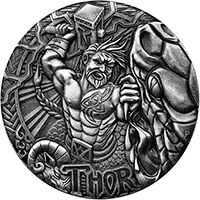
The deity associated with thunder and lightning is an ancient figure found in various mythologies around the world. However, this divine being held particular importance in the myths of the Indo-European peoples.
Within Indo-European cultures, the god connected with thunder often held the position of leader of the celestial deities or ruler of the divine realm. In Indian mythology, this deity was known as Indra, in Greek mythology as Zeus, in Old Russian mythology as Perun, and in Scandinavian mythology as Thor.
In Mesopotamian mythology, the role of the god of storms, rain, and thunder was fulfilled by Ishkur in Sumerian mythology or Adad in Akkadian mythology. This deity was typically depicted with a beard, wielding a club and a thunderbolt, and wearing a headdress adorned with bull horns.
In the Akkadian language, Adad or Haddat was also known as Rammanu (The Thunderer). During the Sassanid era in late Zoroastrianism, Rahman was venerated as a distinct deity associated with prosperity and wealth. He was considered the patron of livestock and the provider of fertile fields and abundant herds.
However, one of the most renowned thunder gods, alongside the Greek Zeus, is the Scandinavian Thor. He is the god of thunder, rain, storms, and fertility, and is considered second in importance only to Odin.
Thor serves as the guardian of both the inhabitants of Midgard and the gods residing in Asgard, protecting them from the malevolent giants known as Jotuns and the subterranean monsters. As the defender of the people of Midgard and the gods of Asgard, Thor safeguards them against the nefarious Jotuns and chthonic creatures.
THE FATE OF ROGER JELLAZNY: A MANIFESTATION OF THE ARCHETYPE
The destiny of American fantasy writer Roger Jelazny serves as a striking representation of the manifestation of the Betelgeuse star archetype, as indicated by its conjunction with the Moon in his astrological chart.
THE CONCEPT BEHIND THE NOVEL CHRONICLES OF AMBER
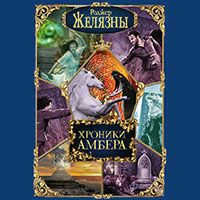

The events of the novel take place in a unique universe that is sustained by the dynamic between two opposing forces – PORRIAGE and CHAOS. In the physical realm, these forces are represented by the kingdom of AMBER and the united kingdom of the courts of CHAOS.
Symbolizing order and chaos are the LABYRINTH and LOGRUS archetypes, which align with the teachings of Carl Jung. These archetypes are imbued with psychic energy drawn from the bloodlines of royal families, granting them the power to manifest their intentions.
Manifestations of these forces are the TOTEM VICTIMS. The EDINOROG represents order, while the Snake embodies chaos.
Alongside this worldwide battle, every realm has its own unique “game of thrones” – a competition for the crown that involves different court factions and ancient noble families.
Therefore, in Roger Géliazny’s book, all facets of the competitive conflict are depicted, ranging from the clash of cosmic forces to the clash of different power factions within one nation, which epitomizes the comprehensive embodiment of the BETHELGEISE ARCHETYPE.
IDENTIFYING THE PROTAGONISTS
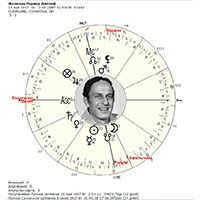
The primary protagonists in the book “The Chronicles of Amber” exhibit a strong semantic connection with the author’s map.
On one hand, there is evidence to suggest that the protagonist in the first part is Prince Corwin of Amber, as this character serves as the narrator for the initial portion of the novel.
Therefore, we can associate Jupiter as his astrological sign, given that it governs the 1st house in Roger Zelazny’s birth chart and is situated in the 12th house, representing locations associated with seclusion, confinement, and psychological disorders.
Prince Corwin is a perfect match for this portrayal in multiple ways. Firstly, he suffered from amnesia for a significant period of time due to a head injury. Secondly, throughout the course of the novel, he finds himself confined for extended periods. Lastly, it is repeatedly mentioned that Corwin enjoyed feigning madness to conceal his true intentions.
Therefore, it would be logical to select the Moon as the ruler of the 5th house, symbolizing Prince Merlin as an astrological indicator. Coincidentally, the Moon serves as the conduit for the influence of the star BETHELGEISE, a crucial celestial body that played a significant role in determining Roger Gélazny’s destiny. Notably, this character not only assumes the central role in the second part of the novel but also serves as a pivotal figure in the entire plot.
Considering that the 9th house in Zhelyazny’s chart is ruled by Mars, it can be inferred that this planet represents the character playing the role of GOD in Zhelyazny’s works.
As a result, Mars has the following negative influences:
Firstly, Mars is positioned in the sign of Sagittarius, where it lacks any essential strengths. Therefore, Mars is considered a PEREGRINE, a planet without dignities, which symbolizes literal pilgrims, or in other words, vagabonds and wanderers in every aspect.
Secondly, Mars is in retrograde motion, which symbolizes literal zigzags on the path of life. Consequently, a character associated with Mars will often be compelled to wander and take indirect routes to achieve their goals.
Thirdly, Mars is located in the DARK ZONE near Rahu, which signifies periodic obscurations of the mind that the character in question will experience.
The character Dworkin in the novel possesses all of these qualities as a magician and sorcerer. He is the one who created the LABYRINTH, using his own blood, and later became the father of the first king of Amber through his connection with the Unicorn.
As a result, Roger Zelazny had a unique and personal god in his life, whom he depicted in the novel as the character Dworkin.
THE INDICATOR OF THE INDIVIDUAL DEMON
Given that the ruler of the 12th house in Zhelyazny’s horoscope was Saturn, situated in Aries – the sign where it is weak, it is not surprising that the antagonists in the book are depicted as feeble and even pitiful beings plagued by a noticeable feeling of inferiority.
Furthermore, there isn’t a single genuine devil in the story, as all the characters who appear as villains in various sections of the book are CONDITIONAL antagonists, carrying out their wicked actions, for instance, driven by a desire for revenge, resentment, or envy, and ceasing to be so as soon as the motive that pushed them onto the treacherous path of villainy disappears.
Simultaneously, all of the characters, who serve as embodiments of the personal devil, are in constant conflict with the protagonist, either engaging in physical altercations or dispatching assassins, or attempting to cause harm by other means.
Undoubtedly, the astrological indication of this recurring theme throughout the entire novel can be found in the fairly precise alignment of SATURN AND MOON in a square aspect, with a slight orb of over a degree.
Given that the Moon, representing the hero, is much stronger in Zhelyazny’s chart compared to Saturn, symbolizing his adversaries, it is not surprising that the hero effortlessly thwarts all endeavors to harm him, leading the villains to eventually realize the futility of their struggle and cease to be the hero’s foes.
As stated by King Random of Amber in the words of Roger Zelazny, our adversaries lack the fortitude to inflict any substantial harm upon us.
SUMMARY
BETHELGEISE serves as a celestial marker for ARCHETYPE, also known as the WONDERFUL WEAPON, upon which a mythological storyline is constructed, commonly referred to as the WAR FOR PRESTOLE or the PRESTOLE GAME.
ROGER ZHELAZNY devised his own distinct MYTH based on this ARCHETYPE, using its plot as the foundation for the universe he created, which in turn serves as the backdrop for the characters he brought to life.

When using material from the website “Arimoya”, it is necessary to include a reference to the site and indicate the author of the article.
Reprinting and placing the material on other websites or in other media outlets
without the consent of the resource owner is prohibited.
To obtain permission, please contact: info@arimoya.ru.
Position of Betelgeuse in the Orion constellation (on the left), a close-up view (in the center), and an image of the star captured with the Very Large Telescope (on the right).
α Ori, 58 Ori (Flemsteed), HR 2061, BD +7 1055, HD 39801, HIP 27989, SAO 113271, FK5 224, WDS J05552 + 0724A.
Betelgeuse ( α of Orion ) is a red supergiant star in the constellation of Orion that belongs to the semi-regular variable type. Its exact distance is not easy to determine. According to a 2008 study, the distance is estimated to be around 197 ± 45 pc (∼643 al ), but in the past it was thought to be located 427 light-years away. In 2013, the Herschel Space Telescope made a new estimate, suggesting that Betelgeuse could be as far as 500 light-years.
Despite being designated as “alpha” in the Bayer system, Betelgeuse is often not the brightest star in the constellation of Orion, with Rigel taking that title. It is one of the three stars that form the vertices of the winter triangle, along with Sirius and Procyon.
Betelgeuse, one of the largest stars known to humanity, is a red supergiant with a radius equivalent to about a thousand times that of the Sun. If it were positioned at the center of our solar system, its massive size would extend from the orbit of Mars to Jupiter, or perhaps even beyond. When this colossal star eventually explodes and transforms into a supernova, its brilliance will be so intense that it will be visible from Earth during daylight for several consecutive days, rivaling the brightness of the Moon. Following this extraordinary event, Betelgeuse will gradually evolve into a nebula, remaining visible in our night sky for thousands of years to come.
The angular diameter of Betelgeuse was initially determined by astronomers Michelson and Pease in 1920-1921, utilizing the Hooker telescope at the Mount Wilson Observatory and employing advanced interferometry techniques.
The variable star is commonly regarded as the eighth most luminous star in the sky, experiencing a decline in its luminosity from November 2019. This decline caused it to drop to the 21st position in 2020. The most likely explanation for this phenomenon is a decrease in brightness in the visible spectrum, known as the Great Darkening (also referred to as the Great Dimming in English), or it could be attributed to the recent formation of a dust cluster near the star. This formation occurred due to a localized temperature drop in the cold zone that emerged on the photosphere. However, its brightness has gradually increased since then, reaching approximately 87% of its original brightness by March 2021.
Summary
- 1 Title
- 2 Characteristics
- 3 Findings
- 3.1 Using the Hooker telescope at Mont Wilson Observatory
- 3.2 With the Hubble Telescope
- 3.3 Utilizing the SPHERE instrument
- 3.4 With the ALMA observatory
- 5.1 Notes
- 5.2 References
- 6.1 Bibliography
- 6.2 Articles about the subject
- 6.3 External Sources
Betelgeuse (also spelled Betelgeuse) is the official designation for a star that was officially recognized by the International Astronomical Union on July 20, 2016.
Many stars have names that originate from Arabic sources, translated into Latin from works on Arabic astronomy. As a result, the brightest stars that comprise the boundaries of the Orion constellation still retain their Arabic names (Betelgeuse, Mintaka, Alnilam, Alnitak, Rigel, and Saif), with the exception of Bellatrix, which has a Latin-derived name.
The term Betelgeuse is believed to have originated from يد الجوزاء, yad al-jawzā’, an ancient Arabic phrase that means “the hand al-jawzā’“. The meaning of the word “al-jawzāh” is uncertain, but it is thought to refer to a female character and possibly stems from a root that means “in the middle”. In ancient Arabia, it may have been used to describe the constellation that encompasses the stars of modern Orion and its central position in the sky. Following the translation of the Almagest, Muslim astronomers began using the term to refer to both the Orion and Gemini constellations, alongside other names.
The term was originally recorded during the Middle Ages in the Bedalgeuse with a diacritical reading error: in Arabic, the letters bāʾ and yā differ only in the number of diacritical marks, with the former having one and the latter having two. During the Renaissance, in order to justify this transcription, the scholar Joseph Scaliger created his own term, bāt al-jawzā, derived from the plural ibt (armpit). This is why the letter “t” appears instead of “d,” and a false etymology has often been repeated. However, the correct etymology has been known since the 17th century thanks to Thomas Hyde.
Properties
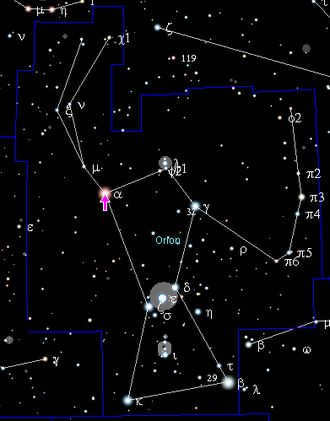
Located on the left shoulder of Orion, Betelgeuse is a prominent star in our galaxy. It stands out due to its orange-red color and its visibility to the naked eye. In fact, it is one of the brightest stars in the Milky Way and is believed to be one of the largest stars in this part of the galaxy. What makes Betelgeuse even more unique is its fluctuating brightness, with its magnitude changing by approximately one star magnitude every 5.7 years. Some estimates suggest that its size is so immense that it could fill the orbital zone of Mars when it is at its normal size, and even expand to the zone of Jupiter as it grows. Interestingly, between 1993 and 2009, Betelgeuse’s diameter actually decreased by 15%, although the exact cause of this phenomenon remains unknown.
This red supergiant star is approximately 1000 times larger than the Sun and emits more radiation than 100,000 Suns combined. However, its mass is only ten to fifteen times that of the Sun, and based on observations made in 2009, it is believed to have reached its maximum size. These characteristics suggest that we are witnessing the final stages of the star’s life. With an age of just a few million years, Betelgeuse is destined to explode and become a supernova that will be easily visible from Earth, even during daylight, within a few thousand years. After the explosion, its core will contract to a diameter of around twenty kilometers and could potentially become a neutron star.
The plumes emitted by Betelgeuse reach impressive sizes comparable to the entire solar system. In July 2009, the European Southern Observatory (ESO) and the Paris Observatory captured detailed images of this red giant using a state-of-the-art telescope located in Chile.

In recent years, significant transformations have occurred within the Orion constellation. The peculiar behavior of its most luminous star, Betelgeuse, has garnered considerable attention. It has been observed to undergo fluctuations in size, either contracting, expanding, or even vanishing entirely. After conducting extensive research, astronomers have formulated two distinct hypotheses to explain this baffling phenomenon.
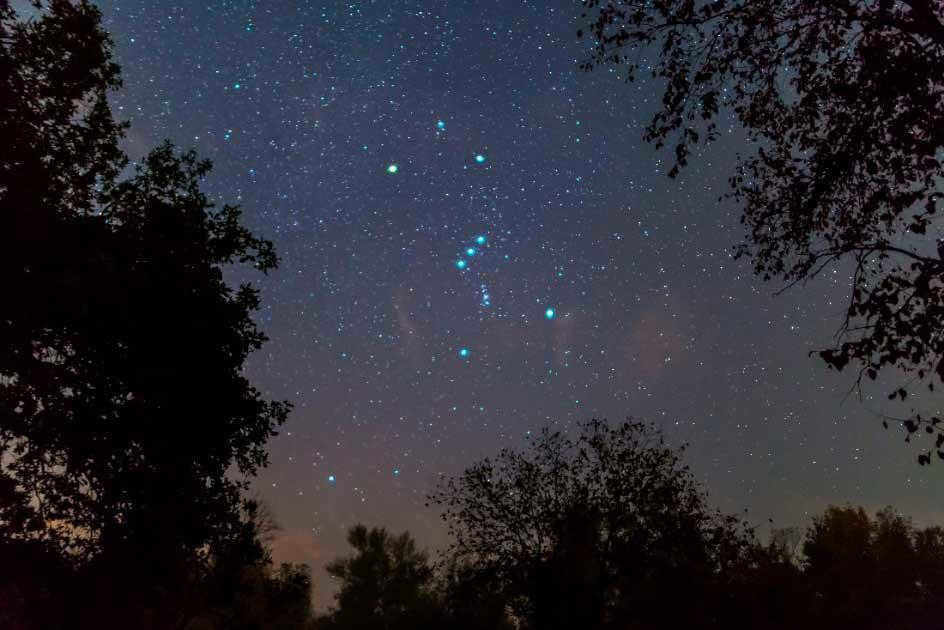
Some information about Betelgeuse
Betelgeuse is a red supergiant star located in the constellation Orion. In order to grasp the enormity of this celestial object, one must understand that it is 300 million times larger than our Sun. To put it into perspective, imagine comparing the size of a soccer ball to that of an entire stadium. Betelgeuse is also 140,000 times more luminous than our Sun, although its temperature is nearly half as hot.
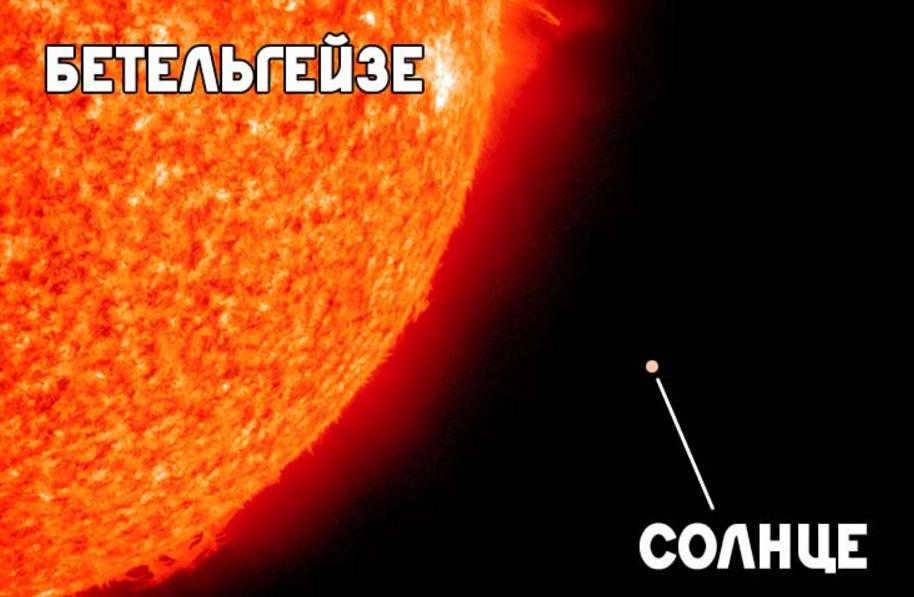
Unsettling Occurrences
In the vicinity of October 2019, Betelgeuse commenced exhibiting peculiar behavior. It intermittently experiences dimming episodes and occasionally vanishes entirely from the nocturnal heavens. Consequently, certain scientists harbor apprehensions that the preeminent star of Orion is on the brink of its demise.
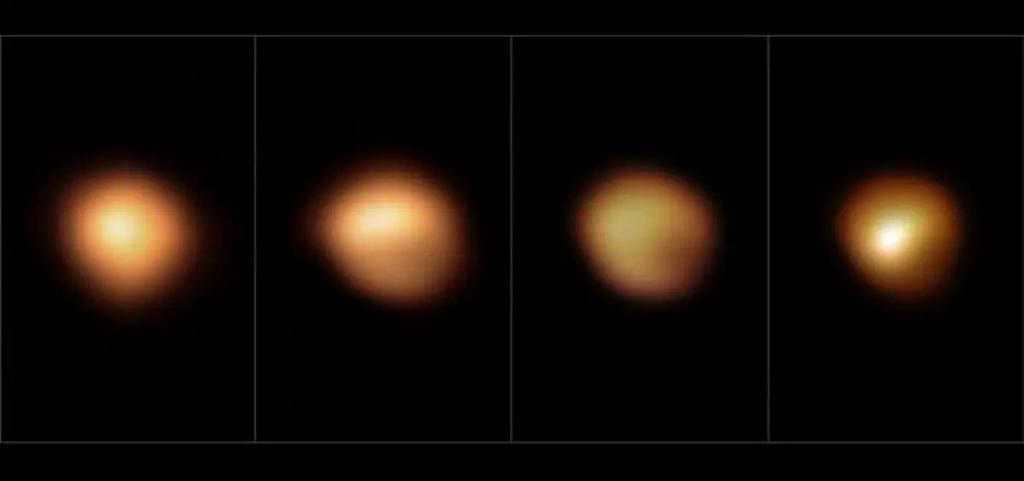
According to astronomers, Betelgeuse is estimated to be approximately 10 million years old. This is considered to be a relatively advanced age for a star of this type, and there is a possibility of it eventually reaching the end of its life cycle. However, it is important not to make hasty assumptions.
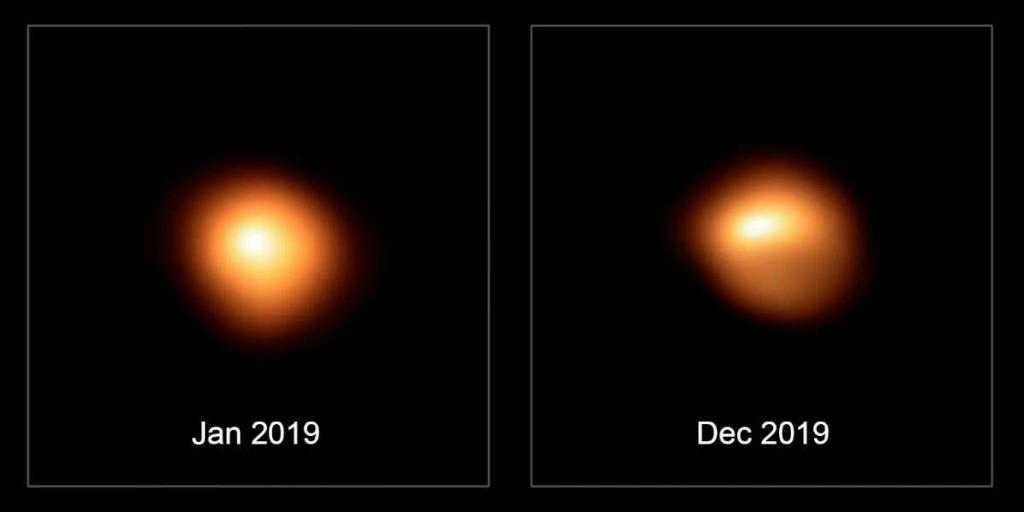
Positive Outlook
There is a hypothesis suggesting that the decline in Betelgeuse’s brightness is a result of a significant dust cloud that is overpowering its light. To put it in simpler terms, it’s as if the star had a “sneeze” and expelled extremely hot plasma from its surface. As this plasma cools down, it transforms into dust. Therefore, once this dust settles or disperses, Betelgeuse might revert back to its previous condition. The star will become visible to the naked eye once again.
An unfavorable outcome
However, it cannot be dismissed that Betelgeuse may meet its demise. There is a proposal that the star has reached its ultimate stage of development, which could potentially culminate in an eruption, resulting in a luminous burst that will illuminate the nocturnal heavens.
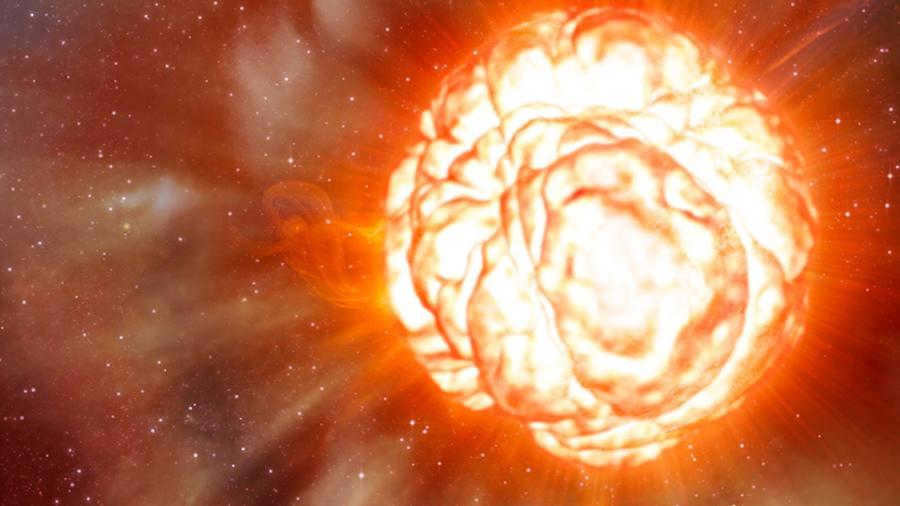
It is impossible to predict when this will happen, as Betelgeuse is not well-researched and the exact distance to it is unknown. Scientific sources present a range of hypotheses. Some suggest that Betelgeuse will perish in a couple of hundred years, while others propose thousands of years. There are even those who believe that the star will endure for millions of additional years.
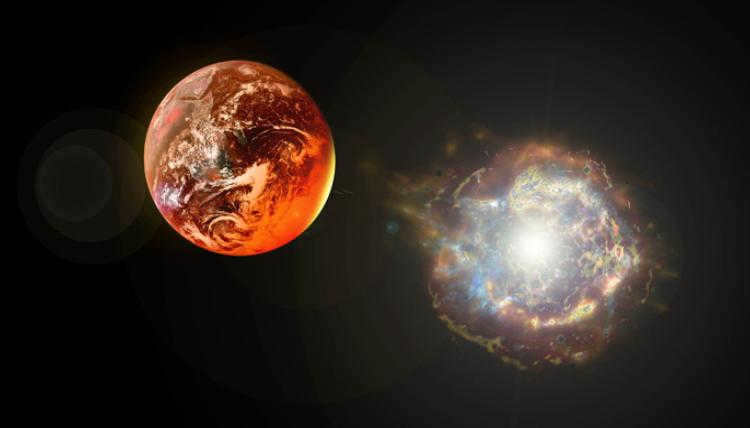
No need for concern
It is unlikely that the current generations will witness the explosion of Betelgeuse. However, even in the event of such an occurrence, there is no cause for alarm. The magnificent burst will have no impact on the processes happening on Earth. Instead, it will simply transform into a captivating astronomical spectacle.
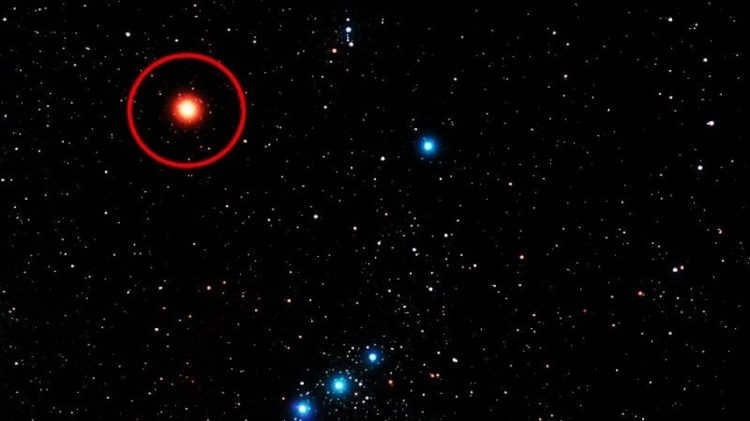
Many astronomers are currently fixated on the enormous star Betelgeuse, which is displaying some very peculiar behavior. Betelgeuse is part of the Orion constellation, which has always been surrounded by myths and legends on Earth. So what exactly is happening to this star and where does its cult following originate from?
Is Betelgeuse’s magnificent life coming to an end?
Betelgeuse, which means “home of the twins” in Arabic, is situated 520 light-years away from Earth. In the grand scheme of the cosmos, that’s considered relatively close.
A recent study has revealed a dark history behind the beauty of Betelgeuse. Scientists have discovered evidence indicating that Betelgeuse actually devoured a smaller neighboring star. This finding may explain why Betelgeuse has been experiencing a significant loss of gas from its atmosphere, resulting in a decrease in its brightness. Typically, when a star like Betelgeuse enters the red giant phase, its rotation speed should decrease. However, Betelgeuse continues to rotate at a staggering speed of 108 km/h, suggesting that it once had a companion star. Based on this hypothesis, it is believed that both Betelgeuse and its stellar neighbor had a mass similar to that of our Sun in the past.
There has been recent speculation among astronomers that the massive Betelgeuse could potentially undergo a supernova explosion in the near future. As you may be aware, the demise of giant stars is accompanied by a highly dramatic event: the eruption of a supernova and the subsequent formation of a luminous gas and dust nebula. The core of a dying star transforms into a neutron star, an incredibly dense celestial object. In the event that the deceased star was of immense size even within the cosmic realm, a black hole will emerge at its place of demise.
Nevertheless, the supernova’s detonation is inexplicably absent, and the Betelgeuse star simply diminishes gradually. According to speculation, Betelgeuse may be undergoing a unique process where it slowly transitions into the final stage of a supernova, fading until it eventually collapses and triggers a powerful energy release. Given that this star is situated 642.5 light years away from Earth, the supernova explosion will be visible even from our planet’s surface, becoming the most luminous object in the night sky for multiple weeks. Scientists anticipate this event to be the second recorded explosion of a dying celestial body in human history, following a similar occurrence in 1054 AD when the star responsible for the formation of today’s Crab Nebula erupted.
However, astronomers and astrophysicists are not only interested in Betelgeuse when it comes to the stars in the Orion constellation. Another intriguing object in this region of outer space is the star Orion Delta, which can be easily seen with the naked eye and is located at the westernmost point of Orion’s Belt. While many people may think of Orion Delta as a single star, it is actually a trio of stars, two of which are massive in size. What makes Orion Delta particularly fascinating is that the orbits of all three stars align in such a way that every 5 days, they pass in front of one another, giving scientists an extraordinary opportunity to study this system in great detail.
The primary star of this triple system, Delta Ori Aa, has a prominent influence on the cosmic surroundings in the vicinity of this system. With a mass exceeding 25 times that of the Sun, it emits the most forceful streams of stellar winds into the surrounding space. Orbiting around this colossal star is a secondary star, which has half the mass of the primary star.
During the investigation of stellar winds emanating from Delta Ori Aa, scientists have obtained intriguing data. It has been discovered that the majority of X-ray radiation is generated through the collision of particles from the stellar winds produced by the system’s two primary stars. Furthermore, a significant portion of the emitted X-rays is created by the collision between wind particles from one star and the surface of the other star, as well as vice versa. The existence of multiple sources of X-ray radiation with slightly varied characteristics within this system has ultimately allowed scientists to elucidate the previously enigmatic discrepancies in the parameters of the radiation fluxes from this system.
Deities from different planets
It is intriguing to note that during the emergence of the initial powerful civilizations on our planet, the worship of Orion held sway for numerous millennia. Remarkably, the Hopi Indians, a native tribe of North America, firmly adhere to the belief that extraterrestrial gods descended upon us from this constellation, specifically from the star known as Pi-3. Situated 26 light years away from Earth, this distance is deemed acceptable for interstellar voyages from a scientific standpoint.
Stretching from the sources of the Amur in the east to the Elbe in the west, primarily in the steppe region of Eurasia, the symbolism of this constellation is widely recognized: the upper portion of the primary collection of reindeer stones (of which there are approximately 700, with about 500 in Mongolia) is arranged in three parallel lines. Deer stones are ancient stone monuments adorned with depictions primarily of “flying” deer (though there are also representations of horses, boars, goats, dogs, panthers, other animals, occasional birds, weapons, geometric shapes, and more), which often encircle and “flow” from one face to the next, as if spiraling upwards.
As for the veracity of the tales told by various cultures regarding celestial gods originating from the stars of Orion, that remains to be determined, while scientists closely monitor the behavior of Betelgeuse in real time, and its future destiny stands as one of the most captivating enigmas in modern science.
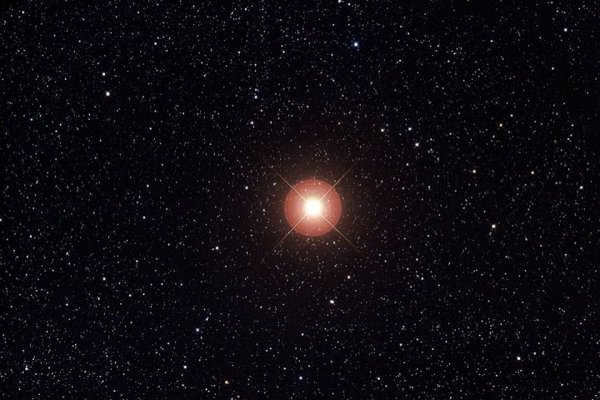
Interpreting Betelgeuse in the Natal Chart in Conjunction with the Planets
The name Betelgeuse is derived from the Arabic phrase “bayt al-jawzah,” which translates to “armpit of the conjugate.” It is believed that Arab astronomers saw this group of stars as representing some form of twin.
Betalgeuse, also known as 58 alpha Orion, is a fixed star. It is classified as a semi-regular variable giant star of the SRc type, with its brightness ranging from 0.40m to 1.3m apparent stellar magnitude in periods of 180 and 2070 days. Betalgeuse belongs to the spectral class M1-2 Ia-Iab. The radius of Betalgeuse is not constant and has an average value of 600 solar radii, which can be attributed to the pulsation of its outer layers. The star has a luminosity of 70,000 solar luminosities, a temperature of approximately 3000 K, and a mass of around 20 solar masses. Betalgeuse is part of a system consisting of six stars, with the largest companion located at a distance of 39.8″ from the main star and having a magnitude of 14.1m. The distance between Betalgeuse and the Sun is 200 pc. Its astronomical position at epoch 2000.0 is AR=05h55m10.3s, D=+07°24’25”; Long=088°45’17”, Lat= -16°01’37”. Betalgeuse is located in the Orion constellation.
A red supergiant of 1st magnitude known as a fixed star, which experiences semi-regular variations in its brightness every 6 years. This star is so enormous that the orbit of Jupiter could comfortably fit inside it. It is located over 400 light-years away and has a luminosity 14,000 times greater than that of the Sun.
An orange star on the left shoulder of Orion that exhibits irregular variations in its brightness. It is referred to as Ibtu-l-Jauz, meaning “Armpit of the Main” or “Giant,” by some sources, while others call it “Coming of the Branch.”
Influence: According to Ptolemy, this star possesses the qualities of Mars and Mercury. Al-Widas mentions a positive aspect with Mercury, Saturn, and Jupiter. It is said to bring military glory, career advancement, and wealth. When positioned in angular houses of a horoscope, it promises good luck, success, and sometimes even eternal fame. However, when in a negative configuration, it can bring melancholy, failure, bitterness, and associated misfortunes.
As a culmination: Exceptional military achievements, leadership, exploration, understanding, opportunities for artistic and scientific growth. When combined with the Sun, Moon, or Jupiter – boundless joy and the utmost accolades.
The influence of Betalgeuse on the planets in the birth chart
When aligned with the Sun: Offers the potential to reach a prominent position in sports, law, the military, or public affairs. However, there is always a risk of losing everything in an instant. A fascination with the occult and mysticism, vulnerability to acute illnesses and fevers; a brilliant, illustrious career culminates in downfall.
When the Moon is present: It cultivates an active mind and strong determination, enabling the individual to gain enduring popularity, happiness, and high honors. However, unexpected losses cannot be ruled out, and there is a possibility of suffering due to disagreements. Behind a reserved exterior lies a rebellious spirit, with successes in the military realm often accompanied by conflicts with superiors. There is also potential for acquiring significant influence, rewards, and prosperity.
With Mercury: It fosters a seriousness of behavior and diligence, allowing one to excel in the legal and financial fields. Fame, whether positive or negative, may manifest, along with a tendency towards self-destruction. This combination encourages seriousness, curiosity, and a inclination towards science and literature. It may also bring modest material wealth and fame for literary works or engravings on metal. Good health is possible, although there may be enough adversity.
When Mars is present: Exercise caution and restraint; it grants you the ability to be a leader, but also an intolerance for any interference in your affairs and a tendency towards irascibility. You possess skill in leadership and organization, and are likely to receive honors and high ranks in the military. However, there is a potential threat of death by lightning, fire, explosion, firearms, and other similar dangers.
When Jupiter is present: You have a deep and inquisitive mind, and are drawn to dangerous and lucrative pursuits. You may receive honors in the church or in the legal profession. Jupiter also promotes public recognition of your achievements, whether in sports, literary work, or community service.
When Saturn is present: You may exhibit cunning and be involved in dodgy and fraudulent activities. There is a risk of betraying friends. Your life is likely to be full of adventure, with many ups and downs. Eventually, wealth may come, but not luxury. This placement is unfavorable for family matters.
When Uranus is present: A quick, efficient, and cunning mind; a sly villain; a renowned fraudster and counterfeiter – although he is rarely caught in the act; outwardly, friendly manners; generosity, warmth; the ability to mesmerize and understand the thoughts of others.
In the presence of Neptune: clairvoyance, aptitude for mechanics; possibly the inventor of some extraordinary device; interest in spiritualism, serious illness or physical suffering, mental illness; limited wealth, material success can only be achieved through a profitable partnership, favorable for marriage and children, conflicts with siblings; in adulthood, a severe test will come.
A conjunction with the ASC may indicate the threat of death by lightning, fire, explosion, firearms, etc.
A. Aich
Opinions of those who came before
Ptolemy asserts that the stars on the shoulders of Orion resemble Mars and Mercury. Robeson makes a connection to military honors. Ebertinus speaks of good luck, achievement, and enduring renown. Rigor agrees and adds in impulsiveness and variability.
Betelgeuse: the idea
Betelgeuse is a remarkable star in the sky, and its impact can lead to significant success without complications. It is located on the right hand, armpit, or shoulder of a deity, symbolizing clarity and strength. Betelgeuse and the other stars in this constellation serve as indicators of fame or success on a local or global scale: the individual under its influence will be productive, brilliant, and fortunate.
Due to its immense strength, Betelgeuse stands out among other stars as one that visibly transforms its expression when viewed from different angles on the chart.
Betelgeuse in the nadir position
A star positioned at the nadir typically suggests that its impact may not be immediately apparent, as its influence may manifest later in life or even after death. Both Abraham Lincoln and Martin Luther King had Betelgeuse in this position. When Betelgeuse was in the nadir, Lincoln’s Jupiter was rising, and although he experienced success during his lifetime (as indicated by the presence of several positive stars in his chart), it was not until after his death that his fame truly skyrocketed. Similarly, Martin Luther King had Betelgeuse in the nadir while the Moon was rising. He achieved success during his lifetime, but it was only after his death that he attained a state of immortality.
The Ascending Betelgeuse
An ascending celestial body showcases its vitality at an early stage. The manifestation of this vitality can then persevere if it receives support from other celestial bodies. If Betelgeuse finds itself in this position, triumph arrives early, potentially indicating a youthful prodigy. A prime example of this is James Dean, who had the rising Betelgeuse accompanied by Jupiter – he attained skyrocketing fame as an actor before his untimely demise in a car accident.
Marilyn Monroe also had Betelgeuse ascending while Mars was reaching its zenith. Through the conjunction of this celestial body with Mars on the Midheaven (the point at which the person will be remembered), she achieved rapid and immense success, not primarily for her acting skills (which would be attributed to Venus), but as a symbol of sexuality – an expression of Mars. She didn’t have to wait for posthumous fame or the recognition that often comes with adulthood.
The Climax of Betelgeuse
At this particular stage, one’s triumphs are experienced in the middle of their life and play a crucial role in shaping their legacy. Charles Dickens, an esteemed writer from the Victorian era, had the fortunate occurrence of Betelgeuse reaching its culmination alongside Jupiter in his astrological chart. While this is not the sole combination involving a fixed star in his chart, it serves as evidence of his immense accomplishments and the lasting impact of his literary works.
The energy of the star is manifested in later life in this position. William Blake’s sun set with this particular star. He was an extraordinary poet and artist who, throughout his lifetime, struggled to make ends meet through printmaking. His name gained immense respect only towards the end of his life and continues to be cherished even after his passing.
Hence, this star is linked to the potential for success and the longevity of one’s work. In this context, Betelgeuse grants individuals the opportunity for immortality. While not everyone with Betelgeuse in their chart will achieve great fame, it remains a crucial ingredient for the possibility of such recognition. Those influenced by it can experience success without having to “endure a dark journey of the soul.”
Betelgeuse in your birth chart
When a planet aligns with Betelgeuse in your natal chart, it indicates that you have unique talents and abilities that can bring you joy, success, and potentially even fame. If Betelgeuse is conjunct with your Moon or Venus, it suggests that you will experience emotional happiness throughout your life. Any area of your life that is influenced by Betelgeuse is likely to yield positive outcomes.
Betelgeuse and its significance as a heliacal rising star during birth
Betelgeuse holds a special place as a celestial and visible heliacal rising star, offering unique benefits to those whose Sun aligns with its rising. This alignment bestows upon individuals the power to achieve success and prosperity. Moreover, it instills a natural charisma fueled by unwavering self-belief. This intrinsic charm has the potential to pave the way for a fulfilling and triumphant life, although its interpretation may vary depending on other astrological factors. In some cases, it may even suggest a hint of rebelliousness or unpredictability.
Brady B.
The primary star in the constellation of Orion is Betelgeuse (also known as Betegeuse or Adacher)
Rigor signifies that when Betelgeuse is in conjunction with the Sun, it bestows a high position in sports, legal, military, and public affairs. The individual may achieve fame and fortune, but there is a risk of losing everything suddenly. If this star aligns with the Moon, the person is likely to become popular and experience long-lasting happiness. They will possess strong determination and an active mind, although there may be instances of unruly behavior and unexpected setbacks. When Betelgeuse is in conjunction with Mercury, it indicates a serious and diligent individual who has the potential to excel in law and finance and gain recognition, whether positive or negative. However, there may also be a tendency towards self-destructive behavior.
Ptolemy stated that Betelgeuse exerts a similar influence as Mars and Mercury. European astrologers, who share the same view on the nature of Betelgeuse, consider the impact of this star to be ambivalent. De Luce observes that when Betelgeuse aligns with the Sun, it leads to constant fluctuations in wealth and honor, eventually resulting in collapse, the potential for blindness due to accidents, diseases, and sudden death. Aligning with the Moon brings empty ambition, losses, blindness due to accidents, honors in military campaigns, and success for surgeons or metallurgists.
Devore’s perspective on this matter is different. Some authors attribute Betelgeuse to the combined influence of Mercury, Saturn, and Jupiter. Referring to Betelgeuse as the “star of war,” Devore notes that when planets align with it, they signify fame and honor, while oppositions can lead to accidents.
Ebertin and Hoffman argue that when Betelgeuse is positioned in the angular houses of the horoscope, it signifies positive outcomes, progress, success, and possibly even everlasting fame. However, if Betelgeuse is located on the ASC or in conjunction with Mars, it indicates the possibility of death caused by lightning, fire, explosion, firearms, and so on.
According to P.Globa, the followers (servants) of Betelgeuse consist of Mars, the Sun, and Neptune. Betelgeuse, as per his observations, is associated with feelings of sadness, grief, melancholy, yearning, anger, and related misfortunes. An individual under the influence of Betelgeuse will possess a peculiar and weighty character. This celestial body represents collapse, downfall, poverty, and accidents. It has the potential to trigger profound and unpredictable rage. Notably, it manifests as a source of danger in times of war, destruction, and loss. People with a prominent Betelgeuse influence are compelled to uncover the essence of things and the profundity of phenomena because their emotions run deep and impact others, compelling them to contemplate the meaning of life. Every action undertaken by such individuals is grave and substantial.
In the field of systematic star interpretation, D. Kutalyov states that Betelgeuse, as the primary star of the constellation, corresponds to the Fire element on the initial, lowest level of manifestation. Being a class M star, it is also linked to Mars. According to this theory, Betelgeuse represents an individual with immense energy, a militant nature, and a tendency towards impulsive actions. They have the potential to lead masses and are sometimes characterized by childlike innocence and straightforwardness. However, it is important for this person’s valor and bravery to not lead to permissiveness, as it may result in negative consequences such as a career collapse or an ideological crisis. They should be guided by higher values rather than selfish motives.
Betelgeuse (α Orion, α Ori) is a prominent celestial object located in the constellation Orion. This star stands out due to its red color and is classified as a red supergiant. It exhibits semi-regular variability, with its luminosity ranging from 0.2 to 1.2 stellar magnitude and averaging around 0.7m. In terms of color index, Betelgeuse has a value of B-V = 1.86m, which contributes to its striking appearance when observed with the naked eye.
When comparing Betelgeuse to our Sun, its luminosity is significantly greater. The minimum luminosity of Betelgeuse is approximately 80,000 times that of the Sun, while the maximum luminosity is around 105,000 times greater. However, determining the precise distance to Betelgeuse is challenging due to its small annual parallax in relation to the angular diameter of its disk.
Based on estimates from 2017, the distance to Betelgeuse is calculated to be approximately 222 parsecs, with an accuracy range of -34/+48 parsecs. This translates to a distance ranging from approximately 613 to 881 light-years.

